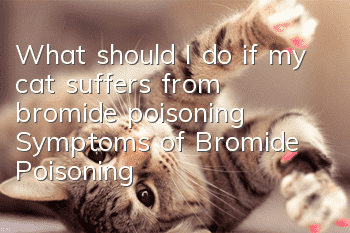What should I do if my cat suffers from bromide poisoning? Symptoms of Bromide Poisoning

In the process of raising cats, cats will get sick due to various reasons, and cat poisoning is not uncommon in life. Cats may be poisoned by accidentally eating drugs, food, and plants. Today we are talking about cat bromide Chemical poisoning, so what is bromide? What should you do if your cat is poisoned by bromide?
1. Symptoms of bromide poisoning in cats
Bromides generally refer to binary compounds containing bromine in the -1 oxidation state. Including metal bromides, non-metal bromides (including some interhalogen compounds that are bromides, such as iodine bromide (IBr)).
When cats are poisoned by bromide, they may show headache, dizziness, fatigue, lack of energy, slow reaction, nausea and vomiting, irritability, irritability, difficulty in speaking, unsteady gait, tremor (obvious in fingers), hyperreflexia of tendons, etc. In addition, the glands of the eyes, nose, throat and respiratory tract are easily affected. Mild conjunctivitis, rhinitis and other symptoms. This is because the secretions of these glands contain bromine.
Some cats may suffer from mental symptoms caused by bromide poisoning, such as: delirium type: loss of orientation, convulsive thinking disorder, hallucinations, delusions, etc. Jijue type: There are a variety of abundant hallucinations and delusions, but its orientation is normal, which is different from the delirium type. This type is less common. Temporary schizophrenia and delusional symptom type: similar to schizophrenia, personality changes, delusions, hallucinations, loss of insight, but normal orientation.
2. How to treat bromide poisoning in cats
If a pet cat accidentally ingests a large amount of bromide, it should immediately drink hypertonic saline and induce vomiting by pharyngeal exploration, and then gastric lavage with isotonic saline, followed by sodium sulfate for catharsis. Because bromide ions are distributed the same as chloride ions in the body and can replace each other, there is little difference in their excretion through the kidneys. After using chloride, the excretion of chloride ions increases, and the excretion of bromide ions increases accordingly. Therefore, give an appropriate amount of ammonium chloride or sodium chloride (table salt) to poisoned cats. For cats with existing heart disease, heart failure, or edema, it is not advisable to use large amounts of sodium chloride. Ammonium chloride can be used instead. The daily dosage for kittens is 75mg/kg, taken orally in 4 times (once an hour at the beginning), until the bromide in the blood drops below 4.85mmol/L (50mg/dl). Also give plenty of fluids to drink. Severely ill patients can use intravenous infusion of normal saline (about 2500ml/m2) or add an appropriate amount of glucose solution. Mannitol and diuretics can also be used to speed up the excretion of poisons through urine. Due to excessive chloride intake, the bromide ions freed from the tissues have no time to be excreted by the kidneys, resulting in a temporary increase in the concentration of serum chloride and aggravating the condition. Severe poisoning can be treated with dialysis, and others can be treated symptomatically. Intravenous fluid rehydration and symptomatic treatment should be given for shock and respiratory depression.
After a cat accidentally eats bromide, the first thing the owner should do is to wash its stomach. It is best to take it to the nearest hospital for timely treatment. The best way is to prevent it in the bud and prevent the cat from getting pregnant.exposure to bromide to ensure the health of your cat.
- How to tame a British Shorthair cat
- There are many fleas, how to deworm cats externally?
- Do cats eat sausages?
- What money must be spent on raising a cat?
- What causes red pimples on a cat’s chin?
- What should I do if my cat doesn’t eat hair removal cream?
- What should I do if my female cat is in heat and keeps meowing?
- Reasons why cats grind their claws and scratching training
- What are the signs that a cat is about to give birth?
- What do Ragdoll cats eat to make their hair pop?



